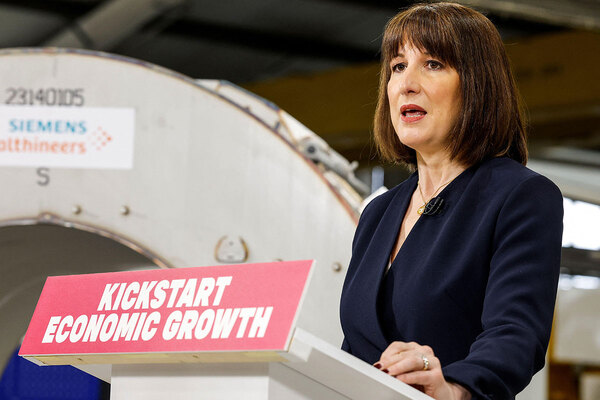You are viewing 1 of your 1 free articles
Dispatches from MIPIM 2024
News editor Stephen Delahunty has spent the week catching up with the UK delegations at the MIPIM 2024 conference in Cannes. He shares his key takeaways
Over the past four days, the world of international property and institutional investors has descended on the picturesque French city of Cannes for the 34th MIPIM property festival.
The annual property jamboree on the French Riviera is a place where blue gilets are mandatory, deals get hammered out over more than enough sparkling wine, and firms and clients hustle to keep each other happy.
Around 21,000 delegates made the journey this year to the Palais des Festivals, Cannes’ renowned conference centre, including about 6,000 from the UK.
City regions and business development districts were out in force, more so than representatives from the social housing sector, as several UK attendees told Inside Housing that there is some concern that being at the event is “not the best look” given the scale of the housing crisis.
Acknowledging this, one former Homes England official said the reality is that the UK is still in competition with the rest of the world, and its well-established presence at the event is key to attracting investment and creating jobs.
With the sun setting on MIPIM for another year, here are Inside Housing’s biggest takeaways.
City regions on display
Ahead of the event this year, investment minister Lord Johnson said: “The UK is one of the best places in the world to invest and our real estate market continues to be robust. From Liverpool to Newcastle to Belfast, the UK has interesting investment opportunities across commercial property, particularly in industrial, science and technology.
“MIPIM is a brilliant opportunity to showcase the UK’s fantastic real estate market to the world’s largest meetings of institutional investors with the capital to back new projects.”
The UK had its own stage at the event, and a number of city regions had a large presence, led by London, Manchester, Liverpool, Newcastle and Belfast.
Cathy Reynolds, director of city regeneration and development at Belfast City Council, told Inside Housing that students and young professionals are driving growth in Belfast despite a lack of access to a number of funding streams English and Welsh cities can access.
Despite the city’s funding challenges, its bright yellow tent at MIPIM was the only one with Guinness on tap.
In Cardiff, the council’s assistant director of development and regeneration highlighted why it was a challenging time to spend social housing grant and how MIPIM offers a chance to create growth and jobs across the region.
The chair of the Southampton City Region said that on the South Coast, the issue for her is an oversupply of the wrong sort of homes, and highlighted a need to stop looking at housing as an isolated problem.
One North East developer told Inside Housing over lunch on a 68ft yacht that speculative housebuilding was no longer viable in the region. His firm had become dependent on partnership working with associations.
With planning never too far from the sector’s mind, he added a little later: “We really need to take the politics out of it.”
Do investors really want less regulation?
Rob Perrins, chief executive of brownfield specialist Berkeley Group, said the government had created chaos for buy-to-let investors.
He said: “For any tall buildings we still don’t know the regulatory rules. My first thing to say to the minister, there’s no shortage of money out there. To get the homes London needs you need £20bn of development capital.
“You can’t raise £1 of this today in the UK. To make a return, there is none coming, partly because of all the regulatory changes. If you go to investors overseas and you can’t answer how many staircases or lifts you need, then they’re not going to invest.
“We’ve been waiting since 2017 for this government to sort out the policies it wants, and bring them in quickly to provide us with certainty. So there is a capital side issue, but regulation, planning and the economic situation are all playing their part.”
Many in the sector share his frustration over a lack of clarity on second staircases. But the UK has been an international outlier in only requiring one staircase, so aligning itself with the rest of the world shouldn’t come as that much of a shock to investors.
He also failed to mention the major event that triggered this government’s drive towards improving building safety: the Grenfell Tower fire.
It was partly the government’s ideological aversion to red tape that contributed to the national tragedy that killed 72 people – the greatest loss of life in a residential fire since World War II.
Still, Mr Perrins said everyone wants to invest in London and the UK.
He did highlight one country with a not-so-great human rights record and its ability to raise billions of pounds in cash for new developments, before lamenting: “We can’t get planning permission because we have to do a bat survey.”
Throughout the event, many of the UK speakers on panel discussions were asked what more the government could do to intervene in the sector, to which the answer was often “nothing”.
Housing association development cutbacks a concern
I’m not sure the above is the best advice, given homelessness and rough sleeping are both on the rise, and landlords are cutting back on development plans as they look to invest in existing stock to tackle a range of issues from fire safety to damp and mould.
One area where I did agree with Mr Perrins was the need for the Affordable Housing Programme (AHP) to be spending many billions more a year than it currently does.
Mr Perrins was speaking around one month after London’s biggest social landlords revealed that starts of affordable homes in the current financial year are expected to have fallen by 76%, to 1,769, in the capital, compared with 7,363 the previous year.
He said: “I think we need every part of the market to work, we need the private house builders who do the cross-subsidy model. But the cross-subsidy model doesn’t produce as many homes as required.
“The grant settlement needs to be more like £4.5bn a year. We want housing associations and councils to build but the associations pulling out of development is a real concern at this point in the market.”
The current AHP will distribute £11.5bn between 2021 and 2026. Mark Farmer, chief executive of Cast Consultancy, called for a “complete reset of the AHP”.
He said: “I think we’ve just got a fundamentally out-of-kilter grant regime in the UK. The gradual reduction over the years in grant has pushed most housing associations into the need to do cross-subsidy and effectively become developers to prop up their core business model.
“And that’s got unintended consequences; naturally then [that] creates a synchronised downturn. So we haven’t got a counter-cyclical pushback from affordable housing providers.”
Swiss army knifes are great
Amid the concern with the AHP, Peter Freeman, chair of Homes England, took to the UK stage and spoke of his first meeting with the housing secretary.
He said: “When Michael Gove became secretary of state, he asked me what we do and I started explaining this and that and he said ‘you’re my Swiss army pen knife’, and I’ve always thought they were a great thing and I’m proud to be chairing one.”
Mr Freeman then went on to give attendees the 101 introductory talk on what the government housing agency does. He admitted that not all of its recent investments had worked out, but said it had to be brave to help get more of the homes the UK needs built at a faster pace.
I assume he was talking about Yorkshire-based modular builder Ilke Homes, which owed more than £68m to Homes England when it collapsed in June last year.
Mr Freeman followed housing minister Lee Rowley, who gave a short speech on how open the UK is for business and how the country “is moving in the right direction, and that means more investment opportunities”.
There was no mention of housing or any sort of crisis, obviously a tough sell. I missed the first few minutes of Mr Rowley as I skipped between events. “Did I miss anything?” I asked the boss of a property technology firm afterwards. “Not much,” she replied.
Sign up for our daily newsletter
Already have an account? Click here to manage your newsletters














